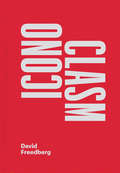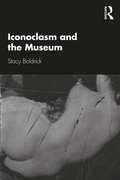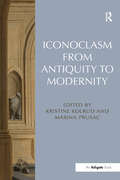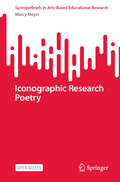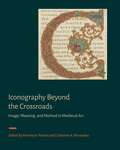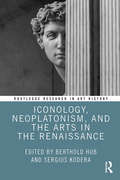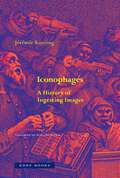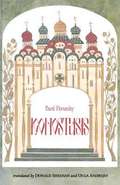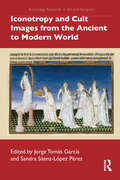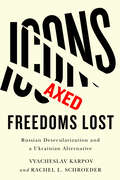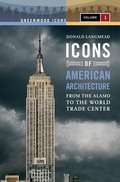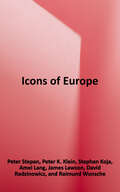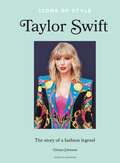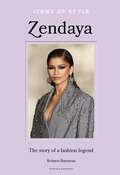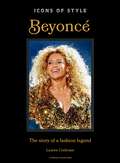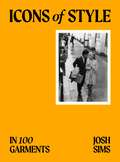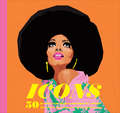- Table View
- List View
Iconix: Exceptional Product Design
by Wolfgang JoenssonIconix is a comprehensive collection of iconic product design objects, chronologically organized from the beginning of the Industrial Revolution to the present. Each spread of this richly illustrated book showcases the author’s representation of the chosen design, expressing its essence and capturing its spirit. In the introductory text, he shares his concept of the term iconicity to help the reader understand what makes these products stand out and why they are considered icons today. More than one hundred remarkable product designs from all areas, including household appliances, everyday objects, furniture, entertainment technology and office equipment, are presented in this collection. Accompanying the images are well-researched and charming vignettes about each product, with amusing insights and fun tidbits of information about its time and place. Each one informs how design has been influenced by changes in technology, science, and society. While these products were considered innovative at their inception, all have withstood the test of time and many are still, remarkably, in use today. Whether you are drawn to this book because of an interest in design or a penchant for nostalgia and the objects that trigger memories—or both—you will undoubtedly recognize quite a few of these products, such as the Coca-Cola bottle, the Wester & Co pocket knife, the Kitchen Aid mixer, the Le Creuset Dutch oven, the Weber grill, the Bic cristal pen, the Rolodex address file, Kikkoman soy sauce bottles, the Kodak Instamatic, the Polaroid SX-70, the SONY Walkman, the Apple MacIntosh, and the Dyson air-multiplier. Maybe they were part of your childhood or represent your ideal in design; certainly, they will evoke a sense of the familiar. Iconix is an engaging and accessible presentation of the history of product design, providing an extensive catalog of the most memorable product designs of the past 150 years.
Iconoclasm
by David FreedbergWith new surges of activity from religious, political, and military extremists, the destruction of images has become increasingly relevant on a global scale. A founder of the study of early modern and contemporary iconoclasm, David Freedberg has addressed this topic for five decades. His work has brought this subject to a central place in art history, critical to the understanding not only of art but of all images in society. This volume collects the most significant of Freedberg’s texts on iconoclasm and censorship, bringing five key works back into print alongside new assessments of contemporary iconoclasm in places ranging from the Near and Middle East to the United States, as well as a fresh survey of the entire subject. The writings in this compact volume explore the dynamics and history of iconoclasm, from the furious battles over images in the Reformation to government repression in modern South Africa, the American culture wars of the early 1990s, and today’s cancel culture. Freedberg combines fresh thinking with deep expertise to address the renewed significance of iconoclasm, its ideologies, and its impact. This volume also provides a supplement to Freedberg’s essay on idolatry and iconoclasm from his pathbreaking book, The Power of Images. Freedberg’s writings are of foundational importance to this discussion, and this volume will be a welcome resource for historians, museum professionals, international law specialists, preservationists, and students.
Iconoclasm and the Museum
by Stacy BoldrickIconoclasm and the Museum addresses the museum’s historic tendency to be silent about destruction through an exploration of institutional attitudes to iconoclasm, or image breaking, and the concept’s place in public display. Presenting a selection of focused case studies, Boldrick examines long-standing desires to deface, dismantle, obscure or destroy works of art and historic artefacts, as well as motivations to protect and display broken objects. Considering the effects of iconoclastic practices on artworks and cultural artefacts and how those practices are addressed in institutions, the book examines changing attitudes to the intentional destruction of powerful artworks in the past and present. It ends with an analysis of creative destruction in contemporary art making and proposes that we are entering a new phase for museums, in which they acknowledge the critical roles destruction and loss play in the lives of objects and in contemporary political life. Iconoclasm and the Museum will be important reading for academics and students in fields such as museum and gallery studies, archaeology, art history, arts management, curatorial studies, cultural studies, history, heritage and religious studies. The book should also be of great interest to museum professionals, curators and collections management specialists, and artists.
Iconoclasm from Antiquity to Modernity
by Kristine Kolrud Marina PrusacThe phenomenon of iconoclasm, expressed through hostile actions towards images, has occurred in many different cultures throughout history. The destruction and mutilation of images is often motivated by a blend of political and religious ideas and beliefs, and the distinction between various kinds of ’iconoclasms’ is not absolute. In order to explore further the long and varied history of iconoclasm the contributors to this volume consider iconoclastic reactions to various types of objects, both in the very recent and distant past. The majority focus on historical periods but also on history as a backdrop for image troubles of our own day. Development over time is a central question in the volume, and cross-cultural influences are also taken into consideration. This broad approach provides a useful comparative perspective both on earlier controversies over images and relevant issues today. In the multimedia era increased awareness of the possible consequences of the use of images is of utmost importance. ’Iconoclasm from Antiquity to Modernity’ approaches some of the problems related to the display of particular kinds of images in conflicted societies and the power to decide on the use of visual means of expression. It provides a deeper understanding of the mechanisms of the phenomenon of iconoclasm. Of interest to a wide group of scholars the contributors draw upon various sources and disciplines, including art history, cultural history, religion and archaeology, as well as making use of recent research from within social and political sciences and contemporary events. Whilst the texts are addressed primarily to those researching the Western world, the volume contains material which will also be of interest to students of the Middle East.
Iconographic Method in New World Prehistory
by Vernon James Knight Jr.This book offers an overview of iconographic methods and their application to archaeological analysis. It offers a truly interdisciplinary approach that draws equally from art history and anthropology. Vernon James Knight, Jr begins with an historiographical overview, addressing the methodologies and theories that underpin both archaeology and art history. He then demonstrates how iconographic methods can be integrated with the scientific methods that are at the core of much archaeological inquiry. Focusing on artifacts from the pre-Columbian civilizations of North and Meso-American sites, Knight shows how the use of iconographic analysis yields new insights into these objects and civilizations.
Iconographic Research Poetry (SpringerBriefs in Arts-Based Educational Research)
by Marcy MeyerThis open access book introduces readers to the craft of writing iconographic research poetry in a way that is scholarly, yet playful. By tracing the historical foundations of concrete and iconographic poetry, as well as the development of research poetry and poetic inquiry, the book examines the intellectual roots that inform this unique methodological approach. The book offers a detailed description of the methods that can be used to design iconographic research poetry. It includes step-by-step description of strategies that researchers can use to create iconographic research poetry from qualitative data. By explicating the processes by which data can be represented in the form of iconographic research poetry and offering exemplars, readers will find specific hands-on strategies for creating their own iconographic research poems. The book contains writing exercises designed to help aspiring iconographic research poets exercise their poetic imagination. It also provides qualitative research instructors with suggestions for integrating iconographic research poetry into the classroom.
Iconography Beyond the Crossroads: Image, Meaning, and Method in Medieval Art (Signa: Papers of the Index of Medieval Art at Princeton University)
by Pamela A. Patton and Catherine A. FernandezThis volume assesses how current approaches to iconology and iconography break new ground in understanding the signification and reception of medieval images, both in their own time and in the modern world.Framed by critical essays that apply explicitly historiographical and sociopolitical perspectives to key moments in the evolution of the field, the volume’s case studies focus on how iconographic meaning is shaped by factors such as medieval modes of dialectical thought, the problem of representing time, the movement of the viewer in space, the fragmentation and injury of both image and subject, and the complex strategy of comparing distant cultural paradigms. The contributions are linked by a commitment to understanding how medieval images made meaning; to highlighting the heuristic value of new perspectives and methods in exploring the work of the image in both the Middle Ages and our own time; and to recognizing how subtle entanglements between scholarship and society can provoke mutual and unexpected transformations in both. Collectively, the essays demonstrate the expansiveness, flexibility, and dynamism of iconographic studies as a scholarly field that is still heartily engaged in the challenge of its own remaking.Along with the volume editors, the contributors include Madeline H. Caviness, Beatrice Kitzinger, Aden Kumler, Christopher R. Lakey, Glenn Peers, Jennifer Purtle, and Elizabeth Sears.
Iconology, Neoplatonism, and the Arts in the Renaissance (Routledge Research in Art History)
by Berthold HubThe mid-twentieth century saw a change in paradigms of art history: iconology. The main claim of this novel trend in art history was that renowned Renaissance artists (such as Botticelli, Leonardo, or Michelangelo) created imaginative syntheses between their art and contemporary cosmology, philosophy, theology, and magic. The Neoplatonism in the books by Marsilio Ficino and Giovanni Pico della Mirandola became widely acknowledged for its lasting influence on art. It thus became common knowledge that Renaissance artists were not exclusively concerned with problems intrinsic to their work but that their artifacts encompassed a much larger intellectual and cultural horizon. This volume brings together historians concerned with the history of their own discipline – and also those whose research is on the art and culture of the Italian Renaissance itself – with historians from a wide variety of specialist fields, in order to engage with the contested field of iconology. The book will be of interest to scholars working in art history, Renaissance history, Renaissance studies, historiography, philosophy, theology, gender studies, and literature.
Iconophages: A History of Ingesting Images
by Jérémie KoeringAn unprecedented art-historical account of practices of image ingestion from ancient Egypt to the twentieth centuryEating and drinking images may seem like an anomalous notion but, since antiquity, in the European and Mediterranean worlds, people have swallowed down frescoes, icons, engravings, eucharistic hosts stamped with images, heraldic wafers, marzipan figures, and other sculpted dishes. Either specifically made for human consumption or diverted from their original purpose so as to be ingested, these figured artifacts have been not only gazed upon but also incorporated—taken into the body—as solids or liquids.How can we explain such behavior? Why take an image into one&’s own body, devouring it at the risk of destroying it, consuming rather than contemplating it wisely from a distance? What structures of the imagination underlie and justify these desires for incorporation? What are the visual configurations offered up to the mouth, and what are their effects? What therapeutic, religious, symbolic, and social functions can we attribute to these forms of relations with icons? These are a few of the questions raised in this investigation into iconophagy.Iconophages aims to retrace, for the first time, the history of iconophagy. Jérémie Koering examines this unexplored facet of the history of images through an interdisciplinary approach that ranges across art history, cultural and material history, anthropology, philosophy, and the history of the body and the senses. He analyzes the human investment, in terms of culture and imagination, at stake in this seemingly paradoxical way of experiencing images. Beyond the hidden knowledge unearthed here, these pages bring to light a new way of understanding images, just as they illuminate the occasionally outlandish relations we maintain with them.
Iconostasis
by Pavel FlorenskyIconostasis is Fr. Pavel's final theological work. Composed in 1922, it explores in highly original terms the significance of the icon: its philosophic depth, its spiritual history, its empirical technique. In doing so, Fr. Pavel also sketches a new history of both Western religious art and the Orthodox icon: a history under the direct operation of the Holy Spirit. The work is original, challenging and profoundly articulate. This translation is the first complete English version.
Iconotropy and Cult Images from the Ancient to Modern World (Routledge Research in Art and Religion)
by Jorge Tomás GarcíaThe book examines the process of symbolic and material alteration of religious images in antiquity, the middle ages and the modern period. The process by which the form and meaning of images are modified and adapted for a new context is defined by a large number of spiritual, religious, artistic, geographical or historical circumstances. This book provides a defined theoretical framework for these symbolic and material alterations based on the concept of iconotropy; that is, the way in which images change and/or alter their meaning. Iconotropy is a key concept in religious history, particularly for periods in which religious changes, often turbulent, took place. In addition, the iconotropic process of appropriating cult images brought with it changes in the materiality of those images. Numerous accounts from antiquity, the middle ages and the modern period detail how cult images were involved in such processes of misinterpretation, both symbolically and materially. The book will be of interest to scholars working in art history, visual culture and religious history.
Iconotropy and Cult Images from the Ancient to Modern World (Routledge Research in Art and Religion)
by Jorge Tomás GarcíaThe book examines the process of symbolic and material alteration of religious images in antiquity, the middle ages and the modern period. The process by which the form and meaning of images are modified and adapted for a new context is defined by a large number of spiritual, religious, artistic, geographical or historical circumstances. This book provides a defined theoretical framework for these symbolic and material alterations based on the concept of iconotropy; that is, the way in which images change and/or alter their meaning. Iconotropy is a key concept in religious history, particularly for periods in which religious changes, often turbulent, took place. In addition, the iconotropic process of appropriating cult images brought with it changes in the materiality of those images. Numerous accounts from antiquity, the middle ages and the modern period detail how cult images were involved in such processes of misinterpretation, both symbolically and materially.The book will be of interest to scholars working in art history, visual culture and religious history.
Icons Axed, Freedoms Lost: Russian Desecularization and a Ukrainian Alternative
by Vyacheslav Karpov Rachel L. SchroederIn Icons Axed, Freedoms Lost, Vyacheslav Karpov and Rachel L. Schroeder demonstrate how Russia went from persecuting believers to jailing critics of religion and why, in contrast, religious pluralism and tolerance have solidified in Ukraine. Offering a richly documented history of cultural and political struggles that surrounded desecularization—the resurgence of religion’s societal role—from the end of the USSR to the Russo-Ukrainian war, they show Russian critics of desecularization adhered to artistic provocations, from axing icons to “punk-prayers” in cathedrals, and how Orthodox activists, in turn, responded by vandalizing controversial exhibits and calling on the state to crush “the enemies of the Church.” Putin’s solidifying tyranny heard their calls and criminalized insults to religious feelings. Meanwhile, Ukraine adhered to its pluralistic legacies. Its churches refused to engage in Russian-style culture wars, sticking instead to forgiveness and forbearance. Icons Axed, Freedoms Lost offers original theoretical and methodological perspectives on desecularization applicable far beyond the cases of Russia and Ukraine.
Icons Of American Architecture: From the Alamo to the World Trade Center
by Donald LangmeadThis two-volume encyclopedia of "iconic" examples of American architecture, part of the Greenwood Icons series, discusses 24 of the most memorable structures such as Alcatraz Prison, the Empire State Building and the Washington Monument. Langmead (architecture and design, U. of South Australia) explains the historical significance of each icon by exploring the reasons why it was built and how it became an icon. He provides an architect's view of the unique features of each structure and even provides details on the costs and challenges of construction. He provides plenty of illustrations and photographs of these icons-the images of the Golden Gate Bridge while under construction are particularly striking-and he includes a glossary that makes this reference equally accessible to architectural students and general readers. Annotation ©2009 Book News, Inc., Portland, OR (booknews.com)
Icons in Time, Persons in Eternity: Orthodox Theology and the Aesthetics of the Christian Image
by C.A. TsakiridouIcons in Time, Persons in Eternity presents a critical, interdisciplinary examination of contemporary theological and philosophical studies of the Christian image and redefines this within the Orthodox tradition by exploring the ontological and aesthetic implications of Orthodox ascetic and mystical theology. It finds Modernist interest in the aesthetic peculiarity of icons significant, and essential for re-evaluating their relationship to non-representational art. Drawing on classical Greek art criticism, Byzantine ekphraseis and hymnography, and the theologies of St. Maximus the Confessor, St. Symeon the New Theologian and St. Gregory Palamas, the author argues that the ancient Greek concept of enargeia best conveys the expression of theophany and theosis in art. The qualities that define enargeia - inherent liveliness, expressive autonomy and self-subsisting form - are identified in exemplary Greek and Russian icons and considered in the context of the hesychastic theology that lies at the heart of Orthodox Christianity. An Orthodox aesthetics is thus outlined that recognizes the transcendent being of art and is open to dialogue with diverse pictorial and iconographic traditions. An examination of Ch’an (Zen) art theory and a comparison of icons with paintings by Wassily Kandinsky, Pablo Picasso, Mark Rothko and Marc Chagall, and by Japanese artists influenced by Zen Buddhism, reveal intriguing points of convergence and difference. The reader will find in these pages reasons to reconcile Modernism with the Christian image and Orthodox tradition with creative form in art.
Icons of Europe (World Art Ser.)
by Peter StepanThe fifty-four masterpieces selected give full expression to the spirit of the different cultures in which they were created. World Art: Europe presents a panorama of artworks, ranging from the cave paintings at Chauvet and Early Cycladic figures, works from Ancient Greece and Ancient Rome, through the Middle Ages and the Renaissance, to more recent works by such influential artists as Monet, van Gogh, Picasso, or Beuys. Several traditions are unique to the history of art in Europe, such as the depiction of the individual since the Renaissance period; nowhere else can such exquisite paintings on panel be seen, and seldom is such a brilliant synthesis of the arts to be found as in Gothic cathedrals or in the masterpieces of the Baroque period. Creative genius was accorded respect even in Antiquity, and since the Middle Ages the names of important masters have been known to successive generations. Objects from cultural environments as far apart as Scotland and Crete, the Scythian Steppes, or Samothrace are included alongside works from central European countries such as Italy, Germany, or France. In addition to painting, masterpieces in marble, bronze, and terra-cotta are featured, as well as mosaics, tapestries, stained glass, and objects made of wood, porcelain, and gold. Each of these stunning works of art is accompanied by a cogent commentary by a renowned scholar.
Icons of Style – Taylor Swift: The story of a fashion icon
by Glenys JohnsonGlobal icon. Songwriting sensation. Fashion phenomenon. Welcome to the Taylor-verse.Through stunning photographs that explore key outfits from her style evolution alongside expert analysis, Icons of Style pays homage to the artist whose every outfit tells a tale. From country boots to bejewelled body suits, explore the wardrobe of the girl-next-door-turned-superstar, who connects with fans the world over with her ever-evolving attire, eye-catching looks and signature pieces.Taylor's relatability, integrity and sartorial storytelling mean this fearless fashion queen will never go out of style.
Icons of Style – Taylor Swift: The story of a fashion icon
by Glenys JohnsonGlobal icon. Songwriting sensation. Fashion phenomenon. Welcome to the Taylor-verse.Through stunning photographs that explore key outfits from her style evolution alongside expert analysis, Icons of Style pays homage to the artist whose every outfit tells a tale. From country boots to bejewelled body suits, explore the wardrobe of the girl-next-door-turned-superstar, who connects with fans the world over with her ever-evolving attire, eye-catching looks and signature pieces.Taylor's relatability, integrity and sartorial storytelling mean this fearless fashion queen will never go out of style.
Icons of Style – Zendaya: The story of a fashion icon
by Kristen BatemanFrom child star to style star, Zendaya's fashion remains genre-defying, just like her onscreen characters.Icons of Style charts Zendaya's rise from her early Disney days to showstopping Met Gala moments with over 100 stunning photographs accompanied by insightful text. The star's fearless fashion choices, including tailoring, tutus, sequins and spiderwebs, show she isn't afraid to take risks.Across casual fits and red-carpet couture, Zendaya has remained true to her style DNA through all of her iconic moments.
Icons of Style – Zendaya: The story of a fashion icon
by Kristen BatemanFrom child star to style star, Zendaya's fashion remains genre-defying, just like her onscreen characters.Icons of Style charts Zendaya's rise from her early Disney days to showstopping Met Gala moments with over 100 stunning photographs accompanied by insightful text. The star's fearless fashion choices, including tailoring, tutus, sequins and spiderwebs, show she isn't afraid to take risks.Across casual fits and red-carpet couture, Zendaya has remained true to her style DNA through all of her iconic moments.
Icons of Style: The story of a fashion legend (Icons of Style)
by Lauren CochraneFrom her Destiny's Child days through to her Renaissance era and the arrival of Cowboy Carter, Queen Bey's destiny was always to be fashion royalty.Through stunning photographs and expert text, Icons of Style captures Beyoncé's most iconic and defining looks from the Met Gala to the Super Bowl and countless tours and red-carpet appearances in between. From bejewelled gowns and bodysuits to chaps and fur coats, it's no wonder fans are Crazy in Love for the bestselling artist's looks.
Icons of Style: The story of a fashion legend (Icons of Style)
by Lauren CochraneFrom her Destiny's Child days through to solo stardom, Beyoncé was always destined to become a fashion legend. With over 100 gorgeous photographs and in-depth analysis of every style era, Icons of Style captures Beyoncé's defining looks, including those at the Met Gala, the Super Bowl, countless red-carpet moments and that unforgettable tourdrobe. From bejewelled gowns and bodysuits to chaps and quadruple denim, it's no wonder fans 'bow down' to the bestselling artist's jaw-dropping looks. Whether casual or couture, Beyoncé reigns supreme, a sartorial inspiration for the Beyhive - and beyond.
Icons of Style: in 100 Garments
by Josh SimsBehind nearly every item in the modern wardrobe is a first of its kind - the definitive item, often designed by a single company or brand for specialist use, on which all subsequent versions have been based (and originals of which are now collector items in the booming vintage market). The T-shirt, for example, may now be an innocuous, everyday item, but was created by American company Hanes for US Navy personnel at the turn of the 20th century and was subsequently adopted by sportsmen and bikers. Other items have been designed for sport, farm work or protection, and made their way into everyday usage. Icons of Style examines, garment by garment, the most important and famous of these products - their provenance and history, the stories of their design, the brand/company that started it all and how the item shaped the way we all dress today. As traditional definitions of men's and women's clothes are fast changing, this book combines all key garments for everyone. Inspiring images of the best examples of the garment - from the 1930s to contemporary times, from Marlene Dietrich to Mick Jagger - show the timeless beauty of these garments that are the basics of the stylish.
Icons of Style: in 100 Garments
by Josh SimsBehind nearly every item in the modern wardrobe is a first of its kind - the definitive item, often designed by a single company or brand for specialist use, on which all subsequent versions have been based (and originals of which are now collector items in the booming vintage market). The T-shirt, for example, may now be an innocuous, everyday item, but was created by American company Hanes for US Navy personnel at the turn of the 20th century and was subsequently adopted by sportsmen and bikers. Other items have been designed for sport, farm work or protection, and made their way into everyday usage. Icons of Style examines, garment by garment, the most important and famous of these products - their provenance and history, the stories of their design, the brand/company that started it all and how the item shaped the way we all dress today. As traditional definitions of men's and women's clothes are fast changing, this book combines all key garments for everyone. Inspiring images of the best examples of the garment - from the 1930s to contemporary times, from Marlene Dietrich to Mick Jagger - show the timeless beauty of these garments that are the basics of the stylish.
Icons: 50 Heroines Who Shaped Contemporary Culture
by Micaela HeekinIcons features colorful portraits of 50 of the most admired women in the fields of music, politics, human rights, and film. This diverse and inclusive collection features the world's most inspiring women, including Michelle Obama, Beyonce, Aretha Franklin, Dolly Parton, Ruth Bader Ginsburg, Yayoi Kusama and so many more. From singers to writers, activists to artists, politicians to filmmakers, Icons is a celebration of the strength of women. Illustrated by Monica Ahanonu, each portrait is accompanied by a short biography about what makes each woman a force to be reckoned with. • Share it with other women in your life: mom-to-daughter, daughter-to-mom, friend-to-friend• Read about the lives and accomplishments of each woman, or simply enjoy the enigmatic portraits. Ahanonu's illustrated portraits are both easily recognizable and also an artistic take on each featured woman's likeness and identity.• A smart and empowering collection of female role models• Perfect for those who loved In the Company of Women: Inspiration and Advice from over 100 Makers, Artists, and Entrepreneurs by Grace Bonney and Bygone Badass Broads: 52 Forgotten Women Who Changed the World by Mackenzi Lee

